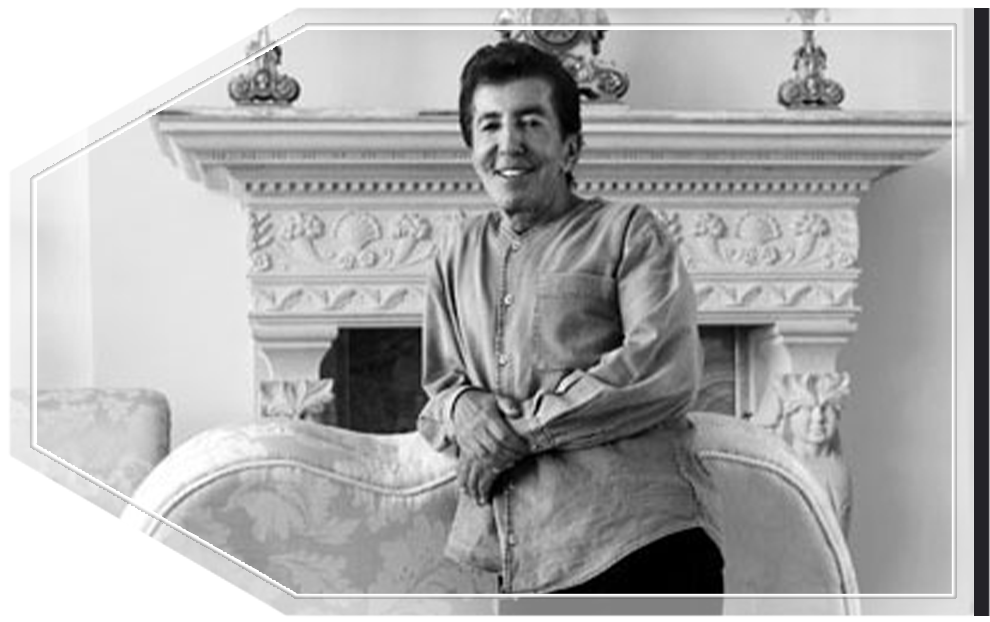FAMILY
LASTING LEGACY

It is a success story that could have been written for Hollywood-imagine the movie trailer now. Alvin Malnik, the son of Russian Jewish immigrants, is born in the roughshod neighborhoods of working-class St. Louis, a teenage gang member who could have easily been eaten alive or fallen astray.
Fast forward to 1964. Malnik is now 31, a multimillionaire, and a well-connected lawyer with celebrity clients who dominate the entertainment business. As time progresses, Malnik transforms into shrewd businessman and a literal pioneer of the South Beach scene, with holdings in real estate and as founder of Miami Beach’s finest institution, The Forge-which would later be taken to new heights by his own son, Shareef, but only once the elder Malnik takes a unique opportunity to work with the Royal Family of Saudi Arabia in the 1980s.
Now it speeds up. Flash frames show Malnik with a slew of the big names across the years-from world-famous attorney and mentor Jake Ehrlich to Rat Pack stars Dean Martin and Sammy Davis Jr., to his first son, Shareef, and his “11th son,” famed director Brett Ratner, to a bevy of beautiful women and a host of others-until, suddenly, the camera pauses, and Malnik finds the love of his life-Nancy. Like clockwork, they fall for each other, marry, expand their family and watch their children grow, as a picturesque sunset fades over his sprawling Palm Beach mansion.

But success is never built overnight, and so for Malnik, no movie trailer could do justice to his life’s bountiful accomplishments. No, to get the real story-the story that cannot be told by any outsider-one must get the opportunity to sit down with the legendary Malnik, to bask in the glory of his opulent 35,000-square-foot Palm Beach home, and truly listen to the story of a man who built an empire out of a big heart and an unflappable will.
“The early days in St. Louis were really two-fold,” Malnik says matter-of-factly of the blue-collar Midwest city. “One of depravation and one of family love. Depravation in the sense of material depravation-our family was very poor, we lived in a poor neighborhood. But there was a really good camaraderie among all of us poor kids because we used to play in the alley, and chase street cars, and do all the goofy things that kids do. Our main sports activity was cork ball, which they never play today, but we used to play in the street. It was not dangerous; everyone’s front door was left open because there was very little crime or robbery back in those days. I came from a very musical family-they were immigrants from Russia, including my dad’s brothers-and we all lived in the same neighborhood and they spoke Russian and Yiddish more than they spoke English. There were a lot of Italians in the neighborhood who spoke Italian rather than English. It was very ethnic in that regard. But it was really a lot of fun, it was memorable.”





Indeed, Malnik came to learn in his youth that success would never be handed to him on a silver platter. Instead, he learned, “It was very important to our parents that my brother and I be professional. That’s really practically all they cared about and we promised them faithfully we would do it-it was easier for my brother than it was for me-but nevertheless, I managed anyway.”
However, applying his motivation to worthwhile causes would wait awhile, as youthful indiscretions highlighted Malnik’s teenage years. A self-described “wild teenager,” Malnik was a gang member, pulling pranks and running amuck with a tough crowd of lower-class thugs. “But the activities of the gangs in those days do not at all relate to the activities of gangs today that would border on or include major criminality. Although, I must say, eventually, once I got out of the neighborhood, those who stayed, a healthy number, in retrospect, did spend quite a bit of time in prison for petty crimes,” he said.
A major turning point of Malnik’s upbringing occurred during high school, when his family moved from a four-family flat to the upstairs of a two-story flat-a minor improvement, but one which made a tremendous impact on the young Malnik. What ensued was a greater understanding of what he could do with his own massive potential.

“I met a new set of friends, and I finally met a lot of kids that were from a better economic situation than I was from, which really instilled a great desire to me to want to have that kind of a life and be able to acquire that kind of material benefits that those parents seemed to give those families. Unfortunately, my mother and father didn’t really assimilate into the American concept. They led kind of a secluded and a bit of a sheltered life, and were satisfied to stay in a lower economic stratum. They thought that the safety net for my brother and myself was that if we were doctors or lawyers, we would be able to make a living, which they weren’t always able to do.”
With his mind set, Malnik aimed for a career in law-with a detour along the way. Joining an ROTC program during his undergraduate studies, Malnik was obligated to spend two years as an Army officer in El Paso, Texas. With such calculated decision-making that flashed a maturity beyond his years, it was somewhat out of character that one major component of Malnik’s law studies was made on a spur-of-the-moment decision.
“Not knowing any better, I got married, and we decided we didn’t want to go back to St. Louis. Neither of us had ever been to Florida or California, which we thought were the glory states-we thought, ‘This is where we need to be.’ We could get away from the cold weather, and the climate, and the regimentation of growing up in a conservative city like St. Louis. So we flipped a coin, and it came out Florida-this was 1956. I had benefits from the GI program, so I was able to register in law school at the University of Miami and I became a lawyer.”

As he toiled away in pursuit of his law degree, Malnik approached yet another turning point in his life with the birth of his first two children, including his first son, Shareef, who would later take over The Forge empire. By the time Malnik crossed the stage to receive his diploma as a graduate at the university in Coral Gables, “Shareef and his sister were born, saying ‘Hi, Daddy,’ to me as I walked across the stage with my diploma.” Though post-graduation did not go according to plan (”I was disappointed because the guy I really liked so much in law school-we had always planned to be partners, we had won the moot court competitions, we were at the top of the class-opted not to do that,”) Malnik, with ample grit from his St. Louis upbringing, took a major risk in starting a practice in, of all places, South Beach.
“I opted to hang out at my shingle on Lincoln Road-605 Lincoln Road on Miami Beach-and I just remember sitting there with my feet on the desk most of the days.” It was during those dog days that Malnik began to build a name for himself as a top-notch attorney. In fact, says Shareef, “As a kid, you have a tendency to want to argue with your parents when you’re five years old. He wasn’t the easiest person to win an argument against.”
And, perhaps most importantly, the elder Malnik’s early days in law practice led to the beginning of a long-standing relationship with Jake Ehrlich, who at the time was perhaps the most famed defender in the United States. As a result of their close bond, Ehrlich put Malnik’s name and full-page photo on the inside cover of his enormously popular book, Never Plead Guilty, which put Malnik on the map around the country as one of the top young lawyers.
“I got a few cases, small cases, started acquiring a reputation as a result of winning them-they were the local bookmakers and all that-so I started a criminal practice, and I got highly recommended, and before you knew it, I had some substantial cases. I had met and participated in a couple of cases with a great lawyer that I admired, Jake Ehrlich, probably the best criminal lawyer in the country, and he was kind enough to care for me and take me on as a junior partner.”

With his career on the fast track to success, Malnik began to chase business pursuits out of his law practice, an idea that would pay off immediate dividends, and which would make a lasting impact on his children-one which is still felt to this day.
“Growing up in that brilliant environment, it has the same effect as law school,” Shareef says. “It changes the chemistry of your brain, makes you think outside the box, and hopefully I’ve adopted that and I try to think outside the box myself. Growing up with him, you learn integrity and ethics. You can’t learn that as an adult, you have to learn that at a young age. Buzz words like loyalty, doing the right thing, and dignity are really words that he lives by, even to his own detriment, he would never sacrifice his dignity or his honor.”
“The trick of the year-this year or any year-has been pulled off by a 31-year-old Miami Beach lawyer who, in a matter of months, has developed holdings worth several million dollars.”
So begins a 1964 front-page story, titled “Success Story: He was a Millionaire in a Wink,” in the Miami Beach Daily Sun regarding Al Malnik. The story is accompanied by a photo of Malnik (he confesses, “I look like I’m taking my bar mitzvah photos in that story”) standing along with mentor Jake Ehrlich, but focuses on Malnik’s first major business venture: Scopitone.Scopitone, a sort of movie jukebox, was a new-fangled invention dripping with promise, and Malnik, riding a wave of success a mile high, bought in. Malnik acquired the U.S. rights to Scopitone, started a movie production company, and hired former Paramount head Irving Briscoe to head up the operation. Debbie Reynolds, then a famous singer-actress, assisted in the film-making, and soon enough, Malnik merged his company in 1963 with another and was paid $2 million for his interest. “I thought, well, I never have to work anymore, a young guy with that kind of money,” Malnik says, laughing.





Luckily for Malnik, his well-connected relationships and reputation as a hard working, innovative business mind left him with several lasting friendships that helped shape new businesses. Through his work with Scopitone, Malnik ended up representing Las Vegas-area hotels such as The Sands, and quickly formed bonds with members of the Rat Pack like Dean Martin and Sammy Davis Jr. Though his law practice slowed, Malnik’s business practice picked up with gusto and panache. “I liked business, I had moved my mom and dad down here, and my brother, because he was ill in St. Louis. At this point, I had four kids, and we lived on Miami Beach on Collins Avenue, and life was good,” he says.
Malnik’s business savvy led to a deep-rooted interest in the South Beach area, which was ripe for opportunity despite having an entirely different continuity at the time.
“Seeing what happened to Miami Beach was amazing-the transition. South Beach was derelicts and bums. Literally, people sleeping in doorways and hallways, and the hotels were replete with retired, old people, who spent their time sitting outside on frayed chairs, almost like where elephants would go to wait to die. It was the most depressing site you could ever imagine,” he said.
Likewise, Malnik had seen the same dreary atmosphere take over the area surrounding his law office. “Lincoln Road, when I got here, was a fashionable place, but it had followed suit with what Miami Beach had turned into, so even though the building of the mall was supposed to revive it, it failed. Through the ’70s, Lincoln Road was a total disaster,” Malnik explains. “All the merchants of any stature had moved. Shopping centers became en vogue, Bal Harbour was built. The Beach was really suffering, and did so for a number of years-it was dangerous to walk down Lincoln Road at night. It was dangerous to walk down Collins or Ocean Drive, it was not well lit, and it was filled with mostly old people and an element of people who did not speak any English, who had illegally come into the country and had no money. It was a question of survival. Yet, you looked at this beautiful ocean and this beautiful beach, and you could never figure out how this came to this. It just made no sense at all.”

Ultimately, there was a great revival-and Malnik was spearheading it. In 1968, along with late partner and best friend Jay Weiss, Malnik opened The Forge-which is a grand institution of Miami to this day (though it is now masterfully owned and operated by Malnik’s son, Shareef)-after Weiss joked with the picky Malnik that the only way to end Malnik’s complaining (Malnik confesses to having never eaten fast food in his life) at restaurants would be by opening his own. After purchasing the Old Forge on 41st Street, Malnik wrecked it and built his own restaurant from the ground up, using his great taste for style to help create an ambiance that is as timeless as it is luxurious. One unforeseen problem: Success was not immediate.
“Within six months, they were saying, ‘It’s the greatest place to look at, but don’t eat there.’ Then I got back into the kitchen and reworked it and it took six or eight months, but it became very successful, and the bar was the hot place on Miami Beach, especially late at night, because celebrities would come over after their shows were over. At the same time, I had a place called the Penthouse on the 79th Street Causeway, and that place rocked and rolled till 5 in the morning.”
Malnik also opened Club 41, a membership-only restaurant located next to The Forge, as well as The Cricket Club in North Miami, a development and private club that was a smashing success in the 70s and 80s, eclipsing the Palm Bay and the Jockey as the hottest new residence. With the Miami Beach landscape forever changed for the better, Malnik focused his attention on a new challenge, one that opened many eyes.

After selling his interest in a variety of business holdings, Malnik ventured out to Saudi Arabia, where, despite his Jewish roots, he was accepted by Saudi Arabia’s royal family immediately. “It was unique, it was definitely an experience, being a Jewish kid from Miami Beach, residing in the royal palaces of Saudi Arabia, and, notwithstanding the many who disagree with what I’m about to say, but the group to which I became associated, the Royal Family, were without prejudice, and I very loudly declared that I was a Jew, though not a devoutly religious one, but proud of my heritage, and they were proud that I said that. I never received any discrimination, from the King or the Crown Prince. They were just a great group of people to be around. We traveled around for years, spent several years together.”
Meanwhile, son Shareef had already begun the transition of The Forge from 60s opulence to modern-day marvel, but not without some life lessons from his father.
“It’s absolutely necessary to think outside the box and be able to change,” Shareef says. “I’ve seen that in his life-the ability to change is so critical, and that’s what I’ll continue to do with The Forge. The world can’t change every time the wind blows, but it has to be relevant to today. The city is different from 40 years ago, when the Forge was founded, and there will be continued change.”
Upon his return, Malnik enjoyed various successes in real estate holdings, including some 4,000 apartments that he owned in San Diego, as well as shopping centers in South Florida-much of which he shrewdly sold off prior to the downturn of the real estate market. Yet, amid all of his various engagements, all this organized chaos, came perhaps the greatest and most cherished change to Malnik’s life: He found true love. “During the course of the days of being single, I encountered a young lady who stopped the clock for me-we met in 1991.” Enlisting the help of Hollywood film director Brett Ratner (whom Malnik lovingly calls his 11th son), Malnik aimed to impress this special woman, Nancy.

“I am blessed to have found the girl of my dreams. Nancy is the most amazing person, the most amazing wife, the most amazing mother. She is truly inspirational,” Malnik says, the love for his wife prevailing through his every word. With the help of Ratner, Malnik devised a way to capture Nancy’s heart. “In order to really impress her, my little godson had to make a movie for the film festivals, so we decided to make a movie that featured Nancy. So Shareef and the whole family, and Brett brought his whole crew from NYU down here, and I was living on a ranch that I had built in Boca Raton and we made a movie called The Good Life. Unfortunately, my plans for Nancy did not quite work out, because if she was going to sleep there, she insisted on having her mother and two sisters present on the ranch while we made the movie. But eventually, true love came to bloom, and in 1995 we were married. Thirteen years later, we have six more kids, which gives me a total of 11 if I’m going to include Brett.”
Malnik’s relationship with Ratner is one of mutual respect and love. “Brett is so special. Since Brett was a baby, he has been so special. And, seeing Brett grow up and achieve everything that he has-everyone thinks he’s at the top of his game, but I don’t. Brett is at the bottom of his game. Brett has so much more capabilities that he is going to find himself in his future achievements that are just amazing. Brett is so capable of not only directing or producing or writing, but he is also very capable of running, and ultimately owning a major studio.”
Their resulting bond also has led to some joint business ventures. “Brett and I are working on some documentaries together-we did one on Brett, and we’ll do a series with other directors. We are also planning some movies that might go directly to DVD, but that’s still in the planning stages.”
Malnik’s love and respect also extend to his 10 children, including son Shareef, who has taken The Forge to new levels since taking over 18 years ago-as well as the Make-A-Wish Foundation, for which the Malnik family has been instrumental, including Shareef’s role as chairman of the ball. “Shareef is really a great restaurateur. I had him, when he was 13 years old, cooking hash brown potatoes in the kitchen, working construction, busing tables, waiting on tables, he was a line cook. He’s done all of these things, and he’s mastered them, he can run a big kitchen, run a big operation, and he can execute it successfully and he’s demonstrated that. That’s why The Forge is doing the great business that it’s doing, plus he’s added the glamour element-the club element.”
Shareef adds: “I picked this up in my travels, that feel for being entertained at a fine restaurant, but I felt those were not mutually exclusive in the United States. I don’t want to be in a restaurant where you hear every spoon hit the saucer, and we are one of the creators of the entertainment aspect during dinner … fashion shows, beautiful people, great music, so that was an important feature. But, never forget that the most important part is food, wine, and service.”





Shareef also has plans for expansion: “The Forge has developed a loyal following of celebrities and world leaders, and the product has been refined and perfected. We want to take it to the next level, starting in Las Vegas, with top markets like Beijing, London, and New York City on the horizon. My goal is to give them the best restaurant in the world, which is elegant and opulent, and unmatched in food, wine, and service.” And that’s not all. Shareef has also branched out his restaurant business to the casual dining experience, with a theme based around “the most important athlete in the country-with the right kind of image to be associated with.” Shareef plans to start with five locations in the state of Florida, using the same methodology of appealing to the customers’ senses that has made The Forge the enormous success it is today
As for the Make-A-Wish Foundation, Al Malnik’s involvement has been life changing-literally. As the foundation’s principal benefactors, Malnik and his wife Nancy have made a lasting impact on countless courageous children. “They literally bring the child back to life by granting a wish,” the grateful Malnik remarks. “They really do. We saw it.”
Of course, says Shareef, the experience is even more rewarding, especially after the situation hit the Malnik family close to home.
“As significant and important as it was, I realized how important Make-A-Wish was when my little brother Jarod was diagnosed with leukemia right when I took over the ball,” Shareef explains. “We were doing this anyway, and as much as you feel for other people’s kids, which is why we do this, let me tell you I have so much more respect because I experienced that. Today, Jarod is cancer-free; he’s been in remission for three years. That’s why Make-A-Wish was always important, but now that’s even more relevant.”

What’s more, much like Jarod, Make-A-Wish is stronger than ever, having raised more than $6 million in the 13 years that the Malniks have held the ball at the Hotel Intercontinental. With the help of Make-A-Wish of Southern Florida CEO Norm Wedderburn and Hotel Intercontinental GM Jack Miller, Shareef says, “The ball last year broke every record, it’s the biggest Make-A-Wish in the United States. We sell out six months in advance. That should give us significant success in the future, as we represent the premier ball.”
Listening to Shareef, one immediately senses the same drive and dedication that took his father to unknown heights of success-success that ranges from the opening of the Jay Weiss Center at the University of Miami’s Miller School of Medicine (in honor of his late best friend) to the Malnik Family Sports Facility at Boca Raton’s St. Andrew School. And, it is this sense of pride in the success of his family and ability to help others that shows what makes Al Malnik so truly special-and his desire to share the life lessons of hard work with his children. With a kind heart and sharp mind, Malnik has succeeded to the highest levels in family and business, leaving his legacy to be lifted by his progeny. There is no doubt that the title bestowed upon him by the Daily Sun still rings very true today: Success story.